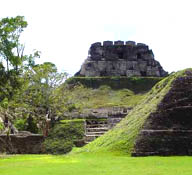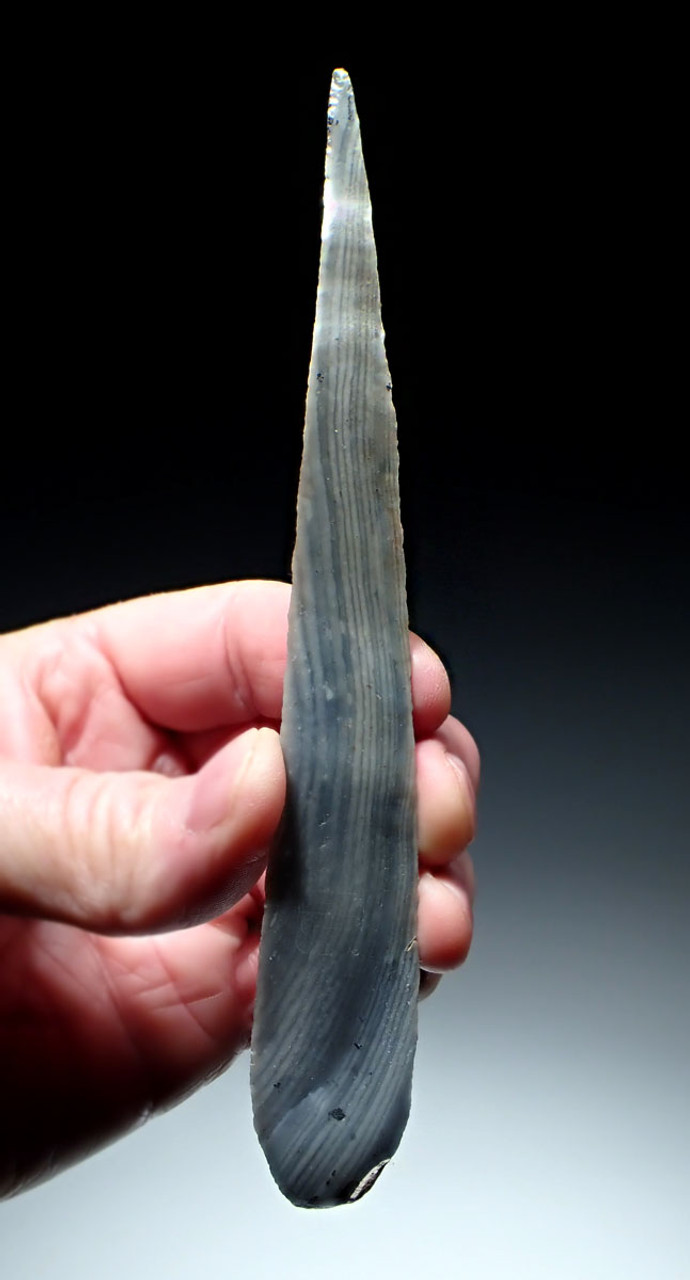Product Description
SEE MORE PRE-COLUMBIAN ARTIFACTS
In all our 24 years of working with major collections of some of the rarest Pre-Columbian weapons and tools, never before have we seen a blood-letting piercer needle this exquisitely flaked in chert, and of this size, and made with such exceptional workmanship. Masterfully flaked out of a single piece of banded chert, this is a massive bloodletting piercing needle that would have been used by ruling elites, shamans and high priests for public blood sacrifice. Its size made it visible to the public from a distance as the ritual was performed atop a pyramid or elevated platform.
This prize specimen was made from a single Levallois struck elongated point. Its extremely narrow profile was then further narrowed by expertly flaking along both edges. Incredible secondary pressure flaking can be seen in the photos. The tip is original as made, and the preservation on this specimen is perfect with no modern damage or breakage. Such work could have only been accomplished by a true master stone-knapper of the ancient Mayan world. Flaked stone objects like this were RARE!
From the famous Dr. Medina Pre-Columbian collection of which documentation will be provided to the buyer.
Blood-letting tools like this can be seen in the ancient codices showing Indians piercing their lips, earlobes, tongues, cheeks and foreskins, to bleed themselves as an offering to the gods. Since this piercer would have required EXTENSIVE flaking by a master craftsperson, such an object would have been extremely costly and only owned by high priests, shamans, or ruling leaders.
Because of the age and fragile nature of this piercer, it is amazing it survived intact and complete. Ancient calcite mineral deposits can be seen on surfaces and deep in flake scars which are indicators ONLY found in AUTHENTIC specimens.
Bloodletting was the ritualized self-cutting or piercing of an individual's body that served a number of ideological and cultural functions within ancient Mesoamerican societies, in particular the Maya. The blood-letting practice usually involved only the highest nobles who would perforate their own body parts, mainly, but not only, their tongues, lips, and genitals. Both men and women practiced these types of sacrifices. Ritualized bloodletting was typically performed by elites, settlement leaders, and religious figures (e.g., shamans) within contexts visible to the public. The rituals were enacted on the summits of pyramids or on elevated platforms that were usually associated with broad and open plazas or courtyards (where the masses could congregate and view the bloodletting). This was done so as to demonstrate the connection the person performing the auto-sacrifice had with the sacred sphere and, as such, a method used to maintain political power by legitimizing their prominent social, political, and/or ideological position.
HISTORY
 Of all the ancient cultures of the Americas, no civilization has held more intrigue and secrets for so long as that of the Mayans. In 1960, their language code of glyphs was finally deciphered and forever changed our view of what we initially thought was a peaceful and harmonious society. On the contrary, the Mayan Culture of the latter years was bathed in the blood of vicious warfare and astounding levels of human sacrifice. Their technology was so advanced it is no wonder many believe they received intelligence from extra-terrestrials. Despite our recent discoveries of Mayan mathematics, astronomy and calendar technology, the Mayans still leave us with many mysteries. Their love of war caused them to manufacture spectacular weapons with inherent beauty and artistry. Their ceramics depict a fascinating culture of status, sacrifice and deep religious devotion to a number of strange gods.
Of all the ancient cultures of the Americas, no civilization has held more intrigue and secrets for so long as that of the Mayans. In 1960, their language code of glyphs was finally deciphered and forever changed our view of what we initially thought was a peaceful and harmonious society. On the contrary, the Mayan Culture of the latter years was bathed in the blood of vicious warfare and astounding levels of human sacrifice. Their technology was so advanced it is no wonder many believe they received intelligence from extra-terrestrials. Despite our recent discoveries of Mayan mathematics, astronomy and calendar technology, the Mayans still leave us with many mysteries. Their love of war caused them to manufacture spectacular weapons with inherent beauty and artistry. Their ceramics depict a fascinating culture of status, sacrifice and deep religious devotion to a number of strange gods.
Archaeologists divide the Mayan Culture into different periods - LATE PRE-CLASSIC / PROTO-CLASSIC (300 BC - 300 AD), EARLY CLASSIC (300 AD - 600 AD), LATE CLASSIC (600 AD - 830 AD), TERMINAL CLASSIC (830 AD - 950 AD). The earliest days of the Maya date back to 2000 BC when small farming villages first appeared in the highlands and Pacific coastline of Guatemala. Crops such as corn, squash and beans made up the staple of their diet and are believed to have been brought from previous migration through Mexico. The Maya pottery styles were unique to the early Maya settlements, though. By 1000 BC, villages sprang up in the lowland regions. The Maya lived in the same locations for centuries and in a continuous state of architectural improvement and expansion leading up to the magnificent 'super-cities' we associate with them today. By 300 AD. full-scale cities were being built with stone featuring massive plazas, temples and pyramids reaching 20 stories high.
It is no wonder that some believe that extra-terrestrial beings brought their knowledge to the Maya. By 300 AD, the first inscriptions suddenly appeared in Maya sites. These early inscriptions were so beautiful it was as if the gods had delivered it to the Mayan themselves! Forward to 600 years later and the inscriptions cease. The first comprehensive writing system in Pre-Columbian America was invented by the Maya. Among the mysteries of the Maya are their amazing understanding of astronomy along with the development of an accurate calendar and mathematical system. Their number system was based on units of 20 and included a concept of 'zero'.
The skills of the Mayan craft are exemplified in their stone and wood carvings, flaked stone objects, pottery and personal adornment. Much of their art centers around their devotion to a religion that is both fascinating and gory. Blood-letting rituals were the norm and many acts of war were motivated by the capture of vast numbers of their enemies for ritual human sacrifice that would run for days on end, forming lakes of blood and fat at the bases of their stone pyramids that defy architectural explanation.
Our understanding of the fascinating MAYAN CULTURE was completely wrong and misinterpreted until as recent as the 1960, when major achievements were made in the deciphering of their glyph language. Elaborately designed ceremonial cities lacking any obvious defenses initially led us to believe that the Mayans were a peaceful theocracy living in ideal harmony with their environment and each other. We could not have been further from the truth. Lowland city-states lived in constant warfare with one another and the thirst of their gods for human blood and sacrifice seemed impossible to satiate.
Perhaps a lesson for us today, recent scientific analysis of the demise of the highly advanced Mayan civilization now answers the biggest mystery of all - "What ever happened to the ancient Mayans?". Long-term high population density (500 people per square mile - the highest in the world at the time) of unbelievable proportions put a strain on their agricultural system that was impossible to sustain. The effects of nutritional deficiencies are evident in bone and tooth analysis on graves dating to the Late Classic Period. It is most probable that starvation put unbearable sociopolitical stress on the society to either kill each other for food or die of hunger necessitated by the technological advancement of warfare and its escalation.
References:
- Fiedel, Stuart J., Prehistory of the Americas, 1992 - Freeman and Company, Early Man in America, 1973
- Hirth Kenneth, Obsidian Craft Production in Ancient Central Mexico, 2006
- Muser, Curt, Facts and Artifacts of Ancient Middle America, 1978
- Phillips, Charles, The Complete Illustrated History of the Aztec and Maya, 2008
 US DOLLAR
US DOLLAR
 EURO
EURO
 AUSTRALIAN DOLLAR
AUSTRALIAN DOLLAR
 CANADIAN DOLLAR
CANADIAN DOLLAR
 POUND STERLING
POUND STERLING




















